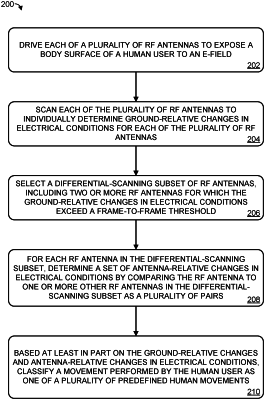| CPC G01V 3/088 (2013.01) [G01V 3/38 (2013.01); G06F 3/012 (2013.01)] | 17 Claims |

|
1. A method for human movement classification, comprising:
at a computing device, driving each of a plurality of RF (radio frequency) antennas to expose a body surface of a human user to an E-field, wherein at least part of a face of the human user is positioned within a near-field region relative to the plurality of RF antennas;
scanning each of the plurality of RF antennas to individually determine ground-relative changes in electrical conditions for each of the plurality of RF antennas relative to a previous time frame;
selecting a differential-scanning subset of RF antennas from among the plurality of RF antennas, including two or more RF antennas for which the ground-relative changes in electrical conditions exceed a frame-to-frame threshold;
for each RF antenna in the differential-scanning subset, determining a set of antenna-relative changes in electrical conditions by comparing the RF antenna to one or more other RF antennas in the differential-scanning subset as a plurality of pairs; and
based at least in part on the ground-relative changes in electrical conditions and the antenna-relative changes in electrical conditions, classifying a movement performed by the human user as a recognized facial expression of a plurality of predefined facial expressions.
|